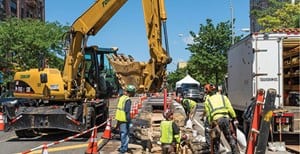The ongoing boom of pipeline construction is probably bigger than you think. Consider this: according to a Pipeline & Gas Journal report, 250 oil and gas companies, ranging in size from 6 million to 1,300 customers, are currently building pipelines throughout the US and Canada. Many of those projects are to rehabilitate older pipelines.
Miles of oil and gas pipelines that were built before 1960 (some as old as the 1920s) are still being used today. That means nearly 50 percent of the U.S. pipeline system is 40 years old or older. As recently as 2016, the federal Department of Transportation (DOT) estimated 30,000 miles of cast-iron pipe still carried gas in the United States, with the highest percentage of these mains located in older eastern cities such as New York City, Philadelphia, Boston, Baltimore, and Washington, D.C. It’s little wonder the aging infrastructure is creating a surge of projects.
Here’s a brief overview of some of the rehab work. DOT data shows that replacement work, while steady, is far from complete:
- In 2015, there were still 27,771 miles of wrought- and cast-iron gas distribution lines in service in the U.S., down from 39,342 miles since 2005, a decrease of almost 30%.
- About 97% of natural gas distribution pipelines in the U.S. were made of plastic or steel at the end of 2017, according to the DOT. The remaining 3% is mostly iron pipe.
- DOT data showed that during the period from 2004-13, distribution companies replaced 17,000 miles of bare-steel mains, leaving about 56,000 miles of bare-steel still in operation.
Along with the ageing infrastructure, the demand on some of these pipelines has increased dramatically from the time of their construction. To meet increasing demand, pipeline operators are adding pipelines and pumping and compression horsepower, reversing flow direction, and converting pipelines from one product to another. These changes are putting the ageing pipeline infrastructure to the test.
To learn how Submar can help your pipeline project bring the entire line up-to-date, visit our services page.


